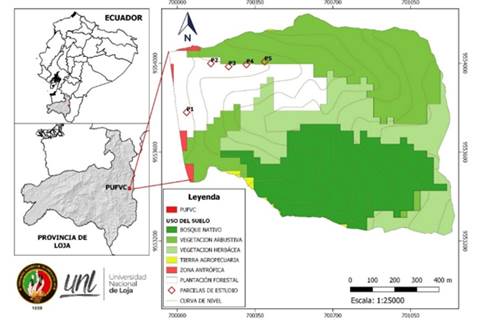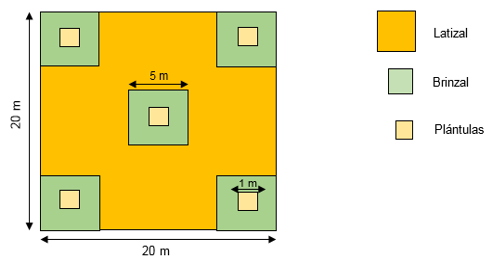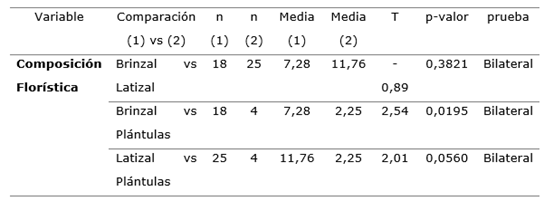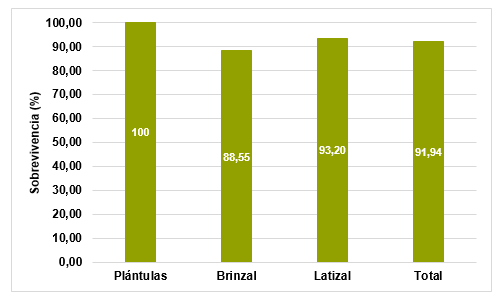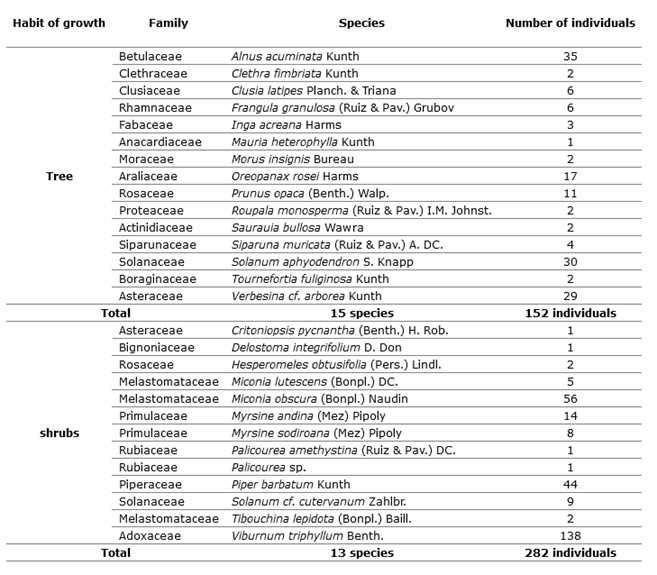Meu SciELO
Serviços Personalizados
Artigo
Indicadores
-
 Citado por SciELO
Citado por SciELO
Links relacionados
-
 Similares em
SciELO
Similares em
SciELO
Compartilhar
Revista Cubana de Ciencias Forestales
versão On-line ISSN 2310-3469
Rev cubana ciencias forestales vol.9 no.2 Pinar del Río maio.-ago. 2021 Epub 06-Ago-2021
Original article
Succession of woody plant species under the Eucalyptus globulus Labill plantation, on Loja valley, Ecuador
1Universidad Nacional de Loja. Ecuador.
Ecosystem dynamics is based on successional processes that occur after anthropic and natural disturbances. The succession of native woody plant species was studied under a plantation of Eucalyptus globulus in Loja, Ecuador; with the objective of determining the floristic composition and monitoring natural regeneration. Five permanent plots of 20 m x 20 m were established to investigate latizales, five subplots of 5 m x 5 m were nested for saplings and five subplots of 1 m x 1 m for seedlings. Height and basal diameter were measured at the beginning of the experiment and at 12 months. Floristic composition and structural parameters were determined at the first sampling time; with the data from the second measurement, survival and growth were evaluated. The influence of the environmental variables: soil depth, slope and luminosity on the floristic diversity and abundance of natural regeneration were analyzed. Twenty-eight species within 24 genera and 21 families were recorded. The abundant species with the highest IVI are: Solanum aphyodendron (seedlings), Miconia obscura (sapling) and Viburnum triphyllum (latizal). Seedlings have a higher survival rate (100 %) and saplings have a lower survival rate (88.55 %). Viburnum triphyllum (seedlings), Verbesina arborea (saplings) and Inga acreana (grassland) showed the highest growth in height. Basal diameter is dominated by Solanum aphyodendron (seedlings), Alnus acuminata (saplins) and Critoniopsis pycnantha (latizal). The floristic diversity present in the latizales correlates with the environmental variables, in the seedlings and saplings there is no significant relationship.
Key words: Successional dynamics; Natural regeneration; Floristic diversity; Environmental variables; Forest plantation.
INTRODUCTION
In the last 50 years, natural ecosystems have been transformed, which has caused strong pressures on the biological attributes that characterize these ecosystems, such as diversity, floristic composition, density and growth of forest stands. This destructive process is occurring in all of Ecuador's ecosystems, caused by land use conversion, deforestation, overexploitation of resources, forest fires, infrastructure works and mining (Aguirre and Weber 2008).
The Andean forest in Ecuador is considered one of the most diverse and complex biological systems in the biosphere; it is also of great value to humanity because it provides goods and services that meet the needs of the societies that live there, such as fruit, wood, firewood, fiber, medicines, climate regulation and water (Tobón 2009; Young 2006; Beck et al., 2008).
The dynamics of Andean ecosystems are based on aspects such as species growth and survival, successional processes that occur after anthropogenic disturbances and their phenological response to exogenous factors (Aguirre et al., 2014). Likewise, understanding the dynamics of a forest and its species involves knowledge of attributes including tree growth and population dynamics, which depend on both environmental factors and species characteristics. Evenly, tree growth rates vary across environmental gradients, which are critical to understanding the problem of species distribution and abundance (Smith and Smith 2007).
The study of successional dynamics is based on the description of the structure and composition of a given forest area and the analysis of the changes it undergoes over time (Aguirre et al., 2014). In addition, it is the only method that allows direct knowledge of the recruitment and mortality rates of each species and the net changes in the structure and composition of a forest during the study period.
With respect to planted forests in the southern region of Ecuador, it has been shown that diverse native plant species are established under these ecosystems (Aguirre et al. 2016). However, little is known about the growth rates and survival rates of these understory species in these ecosystems. On the other hand, the scarce information available on such species is scattered and not very accessible as scientific knowledge (MAE and FAO 2014).
Given this scarcity of information, it is necessary to develop research on successional dynamics in areas that have been altered by the establishment of plantations with exotic species, intensive agriculture and those that have been abandoned after productive processes. This information would provide knowledge for the planning of projects with the use of appropriate species to ensure the sustainability of forest production.
Under this context and with the purpose of generating scientific information on the successional dynamics under Eucalyptus plantations in the Andes of Ecuador, especially in the southern region, this research was carried out; which allowed to identify and know aspects of the successional dynamics of native woody plant species of the understory of a plantation of Eucalyptus globulus established in the University Park "Francisco Vivar Castro" in the province of Loja, Ecuador. The objective of this study was to determine the floristic composition of the natural succession and the growth in diameter and height of the woody plant species under the plantation of Eucalyptus globulus Labill to generate bases for the management of these ecosystems.
MATERIALS AND METHODS
Study area
The research was carried out in a plantation of Eucalyptus globulus Labill (7.50 ha) located in the University Park "Francisco Vivar Castro" (PUFVC), property of the National University of Loja (Figure 1), located in the parish of San Sebastian, canton Loja, Loja province. Located in an altitudinal range of 2 130 - 2 520 m a.s.l., it has an area of 99.13 ha, between UTM coordinates: 700 592 - 9 554 223 N, 700 970 - 9 553 139 S, 701 309 - 9 553 171 E and 699 961 - 9 554 049 W (Aguirre et al., 2016).
Sampling unit and recording of natural regeneration
Five permanent plots of 20 m x 20 m (400 m2) were installed under the Eucalyptus globulus plantation, systematically separated 100 meters from each other. For the study of natural regeneration, the categories proposed by Orozco and Brumer (2002) were used, which are: Seedlings: individuals ≤ 30 cm height; Saplings: individuals > to 30 cm and ≤ 1.50 m height; Latizal: individuals > to 1.50 m height and ≤ to 10 cm diameter.
The recording of latizales was done in permanent plots of 20 m x 20 m, in each of these plots five subplots of 5 m x 5 m (25 m2) were nested for saplings; and, within each subplot (25 m2) a subplot of 1 m2 was nested to count seedlings (Figure 2). The height and basal diameter of each individual in the natural regeneration categories were measured at two sampling times: August 2019 and August 2020.
Each individual within each plot was labeled with a yellow plastic plate, in order to monitor the survival and growth of the species, following the methodology suggested by Aguirre (2019).
Data analysis
With the initial sampling data, floristic diversity and composition were determined for each category of natural regeneration and a t-test was performed to see differences in the floristic composition of the categories of natural regeneration. In addition, the structural parameters of the vegetation were calculated: relative density, relative frequency and importance value index. For the second moment, the survival of each of the species recorded at the end of the study period (nine months) was estimated. In addition, for each species, within each permanent plot, growth in height and growth in diameter were calculated. These analyses for each species were obtained for each category of natural regeneration. For the calculations, the formulas suggested by Aguirre (2019) were applied (Table 1).
Influence of environmental variables on natural regeneration
Three environmental variables were recorded in the area under the eucalyptus plantation in order to evaluate their relationship with the abundance and floristic diversity of the natural regeneration in each of the categories. Brightness was measured using hemispheric photographs of the canopy to determine the percentage of light entering the understory of the eucalyptus plantation; a Canon SX 30 IS camera was used with the 180° fisheye mode, which helps to obtain a better enhancement of the photographs. The slope using a clinometer taking the measurement in percentage (%), the data were recorded for each permanent plot. And the soil depth (O horizon) was measured with a tape measure in each subplot, in order to calculate an average value for each permanent plot. With the collected data, Pearson correlation analysis and principal component analysis (PCA) were performed with the statistical program InfoStat and R, separately for each of the regeneration categories to see the influence of the variables on the floristic composition and abundance.
RESULTS
Floristic composition of the natural regeneration by category
Twenty-eight species were recorded within 24 genera and 21 families, of which 15 are trees and 13 are shrubs (Annex 1), (Table 10). From the sampling under the Eucalyptus globulus plantation, 434 individuals of natural regeneration were recorded. The grassland category has the largest number of individuals (294) belonging to 25 species, the sapling category has 131 individuals of 18 species and seedlings have 9 individuals within four species. The representative species in the latizal category are Viburnum triphyllum, Alnus acuminata and Miconia obscura; in the saplings category are Miconia obscura and Viburnum triphyllum, while Solanum aphyodendron in the seedling category (Table 2). The t-student test determined that the three categories of natural regeneration are statistically equal; no significant differences were evident in terms of floristic composition (Table 3).
Table 2. - Number of individuals per species and category of natural regeneration that regenerate under the Eucalyptus globulus plantation of the University Park "Francisco Vivar Castro", Loja, Ecuador
| Species | Category of natural regeneration | |||
|---|---|---|---|---|
| Latizal | Saplings | Seedlings | ||
|
|
Betulaveae | 27 | 8 | 0 |
|
|
Cletraceae | 1 | 1 | 0 |
|
|
Clusiaceae | 4 | 2 | 0 |
|
|
Asteraceae | 1 | 0 | 0 |
|
|
Bignoniaceae Rhamnaceae | 1 4 | 0 2 | 0 0 |
|
|
Rosaceae | 2 | 0 | 0 |
|
|
Fabaceae | 3 | 0 | 0 |
|
|
Anacardiaceae | 1 | 0 | 0 |
|
|
Melastomataceae | 5 | 0 | 0 |
|
|
Melastomataceae | 27 | 29 | 0 |
|
|
Moraceae | 2 | 0 | 0 |
|
|
Primulaceae | 11 | 3 | 0 |
|
|
Primulaceae | 4 | 4 | 0 |
|
|
Araliaceae | 1 0 | 15 1 | 1 0 |
|
|
Rubiaceae | 0 | 1 | 0 |
|
|
Piperaceae | 26 | 16 | 2 |
|
|
Rosaceae | 3 | 8 | 0 |
|
|
Proteaceae | 2 | 0 | 0 |
|
|
Actinidaceae | 0 | 2 | 0 |
|
|
Actinidaceae | 2 | 2 | 0 |
|
|
Solanaceae | 16 | 10 | 4 |
|
|
Solanaceae | 8 | 1 | 0 |
|
|
Melastomataceae | 2 | 0 | 0 |
|
|
Boraginaceae | 2 | 0 | 0 |
|
|
Asteraceae | 23 | 6 | 0 |
|
|
Adoxaceae | 116 | 20 | 2 |
| Total | 294 | 131 | 9 | |
Structural parameters of natural regeneration
In the seedling category, the abundant species with the highest IVI is Solanum aphyodendron; the frequent species are Solanum aphyodendron and Viburnum triphyllum(Table 4).
Table 4. - Structural parameters of the seedling regeneration category under the Eucalyptus globulus plantation of the University Park "Francisco Vivar Castro", Loja, Ecuador

Density (D); Relative density (RD); Frequency (F); Relative frequency (FR); Importance value index (IVI).
Table 5 shows the structural parameters of the 10 main species of the sapling category under Eucalyptus globulus plantation, based on the highest importance value index (IVI). The species with the highest IVI are Miconia obscura, Viburnum triphyllum and Oreopanax rosei(Table 5).
Table 5. - Structural parameters of the sapling regeneration category under the Eucalyptus globulus plantation of the University Park "Francisco Vivar Castro", Loja, Ecuador
| Species | Family | DInd ha-1 | DR (%) | F | FR (%) | IVI (%) |
|---|---|---|---|---|---|---|
|
|
Melastomataceae | 145 | 22,14 | 4 | 9,76 | 15,95 |
|
|
Adoxaceae | 100 | 15,27 | 4 | 9,76 | 12,51 |
|
|
Araliaceae | 75 | 11,45 | 5 | 12,20 | 11,82 |
|
|
Piperaceae | 80 | 12,21 | 3 | 7,32 | 9,77 |
|
|
Primulaceae | 20 | 3,05 | 4 | 9,76 | 6,40 |
|
|
Solanaceae | 50 | 7,63 | 2 | 4,88 | 6,26 |
|
|
Betulaceae | 40 | 6,11 | 2 | 4,88 | 5,49 |
|
|
Rosaceae | 40 | 6,11 | 2 | 4,88 | 5,49 |
|
|
Primulaceae | 15 | 2,29 | 3 | 7,32 | 4,80 |
|
|
Asteraceae | 30 | 4,58 | 2 | 4,88 | 4,73 |
Density (D); Relative density (RD); Frequency (F); Relative frequency (FR); Importance value index (IVI).
Table 6 shows the structural parameters of the 10 main species of the latizal category under the Eucalyptus globulus plantation, based on the highest importance value index (IVI). The species with the highest IVI are: Viburnum triphyllum, Piper barbatum and Verbesina arborea(Table 6).
Table 6. - Structural parameters of the latizal regeneration category under the Eucalyptus globulus plantation of the University Park "Francisco Vivar Castro", Loja, Ecuador
| Species | Family | DInd. ha-1 | DR (%) | F | FR (%) | IVI (%) |
|---|---|---|---|---|---|---|
|
|
Adoxaceae | 580 | 39,46 | 5 | 8,62 | 24,04 |
|
|
Piperaceae | 130 | 8,84 | 5 | 8,62 | 8,73 |
|
|
Asteraceae | 115 | 7,82 | 5 | 8,62 | 8,22 |
|
|
Melastomataceae | 135 | 9,18 | 4 | 6,90 | 8,04 |
|
|
Betulaceae | 135 | 9,18 | 3 | 5,17 | 7,18 |
|
|
Solanaceae | 80 | 5,44 | 4 | 6,90 | 6,17 |
|
|
Primulaceae | 55 | 3,74 | 4 | 6,90 | 5,32 |
|
|
Rhamnaceae | 20 | 1,36 | 3 | 5,17 | 3,27 |
|
|
Solanaceae | 40 | 2,72 | 2 | 3,45 | 3,08 |
|
|
Melastomataceae | 25 | 1,70 | 2 | 3,45 | 2,57 |
Density (D); Relative density (RD); Frequency (F); Relative frequency (FR); Importance value index (IVI).
Survival of natural regeneration
Under the Eucalyptus globulus plantation, the overall survival of the natural regeneration was 91.94 %, corresponding to 399 individuals. In turn, the seedling category registered 100 % survival, followed by the sapling category with 93.20 %, and the sapling category with 88.55 % (Figure 3).
Growth of natural regeneration
Figure 4 shows the average growth in height and diameter of the natural regeneration under the Eucalyptus globulus plantation of the University Park "Francisco Vivar Castro" (Figure 4).
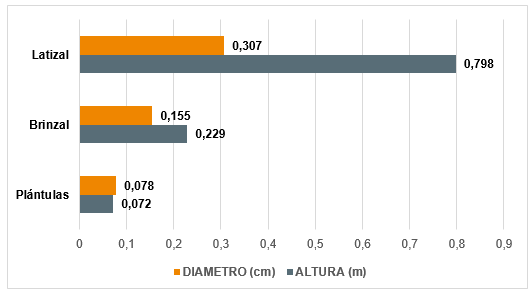
Fig. 4. - Growth of the natural regeneration under the Eucalyptus globulus plantation of the University Park "Francisco Vivar Castro", Loja, Ecuador
The species with the highest average height growth are Viburnum triphyllum (seedlings), Verbesina cf. arborea and Alnus acuminata (sapling); Inga acreana, Morus insignis and Critoniopsis pycnantha (latizal); while the species with the highest average growth in diameter are Solanum aphyodendron (seedlings); Alnus acuminata, Verbesina cf. arborea and Clethra fimbriata (sapling); Critoniopsis pycnantha, Tournefortia fuliginosa and Morus insignis (latizal).
Influence of environmental variables
Regarding the correlation analysis (α = 0.05) between environmental variables and natural regeneration, considering the number of individuals and species; in the seedling category, positive and negative trend relationships were determined (Table 7).
According to the principal component analysis, in the seedling category, a strong correlation was found between slope and lightness (r = 0.68, P = 0,00017), while soil depth had no relationship with lightness (r = 0,0023, P = 0.99). The soil depth variable grouped the majority of seedlings. The numbers of individuals and species are reflected to a greater degree in dimension 2 and have no significant relationship with environmental variables (Table 7 and Figure 5).
Table 7. - Pearson correlation matrix between environmental variables and natural regeneration in the seedling category under the Eucalyptus globulus plantation of the University Park "Francisco Vivar Castro", Loja, Ecuador
| Variables | Number of individuals | Number of species | Depth O horizon | Slope | Lightness |
|---|---|---|---|---|---|
| Number of individuals | < 0,001 | 0,37 | 0,72 | 0,31 | |
| Number of species | 0,86 | 1,00 | 0,07 | 0,89 | 0,69 |
| Depth O horizon | -0,19 | -0,37 | 1,00 | 0,13 | 0,99 |
| Slope | 0,08 | -0,03 | 0,31 | 1,00 | < 0,001 |
| Lightness | 0,21 | 0,08 | 0,002 | 0,68 | 1,00 |
*Values below the diagonal represent the correlation coefficient values above the diagonal indicate the P-value. Values in bold indicate a significant correlation.
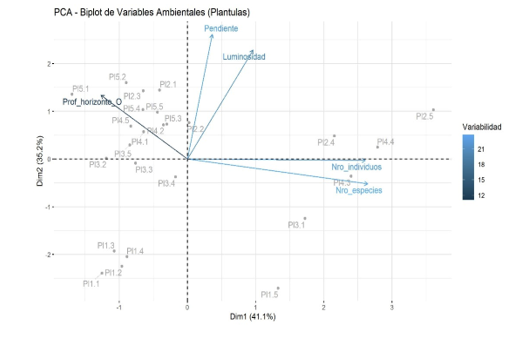
Fig. 5. - Principal component analysis PCA (Biplot) of environmental variables on natural regeneration in the seedling category under the Eucalyptus globulus plantation of the University Park "Francisco Vivar Castro", Loja, Ecuador
In the sapling category, the correlation analysis (α = 0.05) between variables showed positive and negative trend relationships. Luminosity showed a high correlation with slope (r = 0.68, P = 0,00017), while soil depth presented low correlation with slope (r = 0.31, P = 0.13) and no relationship with luminosity (r = 0,0023, P = 0.99). The variables of lightness, slope and soil depth separated the majority of saplings in plots 2, 3, 4, 5 from the saplings in plot 1. The number of species had a low correlation with slope (r = 0.27, P = 0.19) and luminosity (r = 0.22, P = 0.29), while the number of individuals had no relationship with the environmental variables; similarly a negative correlation was observed with soil depth (r = -0.30, P = 0.15). This is confirmed with the correlation matrix (Table 8) and the principal component analysis in Figure 6 (Figure 6).
Table 8. - Pearson correlation matrix between environmental variables and natural regeneration in the sapling category under the Eucalyptus globulus plantation of the University Park "Francisco Vivar Castro", Loja, Ecuador
| Variables | Number of individuos | Number of species | Depth O horizon | Slope | Lightness |
|---|---|---|---|---|---|
| Number of individuos | 0,00021 | 0,15 | 0,88 | 0,83 | |
| Number of species | 0,68 | 1,00 | 0,42 | 0,19 | 0,29 |
| Depth O horizont | -0,30 | -0,17 | 1,00 | 0,13 | 0,99 |
| Slope | -0,03 | 0,27 | 0,31 | 1,00 | 0,0017 |
| Lightness | 0,04 | 0,22 | 0,0023 | 0,68 | 1,00 |
*Values below the diagonal represent the correlation coefficient, values above the diagonal indicate the P-value. Values in bold indicate a significant correlation.
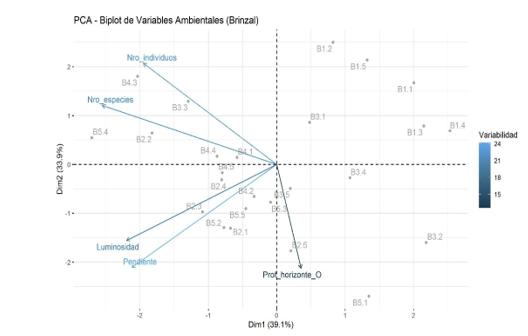
Fig. 6. - Principal component analysis PCA (Biplot) of environmental variables on natural regeneration in the sapling category under Eucalyptus globulus plantation in Loja, Ecuador
Table 9 shows the correlation analysis (α = 0.05) between environmental variables and natural regeneration in the latizal category, considering the number of individuals and species. In turn, the principal component analysis determined a strong correlation between environmental variables and the number of species (r = 0.85; r = 0.79; r = 0.66), while the number of individuals presented a strong negative correlation with environmental variables and the number of species. The variables of luminosity, slope and soil depth separated the latizales of plots 2, 3, 4, 5, from the latizales of plot 1. The slope variable showed a high correlation with luminosity (r = 0.73, P = 0.16) and soil depth (r = 0.74, P = 0.15); on the other hand, luminosity and soil depth had a low correlation (r = 0.32, P = 0.60) (Table 9 and Figure 7).
Table 9. - Pearson correlation matrix between environmental variables and natural regeneration in the latizal category under the Eucalyptus globulus plantation of the University Park "Francisco Vivar Castro", Loja, Ecuador
| Variables | Number of individuals | Number of species | depth O horizon |
| Number of individuals | 0,04 | 0,17 | |
| Number of species | -0,89 | 1,00 | 0,22 |
| depth O horizon | -0,72 | 0,66 | 1,00 |
| Slope | -0,63 | 0,79 | 0,74 |
| Lightness | -0,74 | 0,85 | 0,32 |
*Values below the diagonal represent the correlation coefficient, values above the diagonal indicate the P-value. Values in bold indicate a significant correlation.
DISCUSSION
Floristic composition and structural parameters
The floristic composition under the Eucalyptus globulus plantation of the PUFVC corroborates Real de Abreu et al., (2011) who state that forest plantations can recover high native plant diversity. Furthermore, in agreement with this research, several authors such as Lima (1996), Ferreira et al. (2010), Fernández et al., (2012) report in their studies references of plant diversity growing in stands of several eucalyptus species. In addition, it should be noted that the floristic composition of the understory of forest plantations is important to know the successional dynamics of the species present in these disturbed sites, and in turn, to know the resilience of these ecosystems (Ballester et al., 1982).
Under the Eucalyptus globulus plantation in the PUFVC, 28 species were found, of these 15 are arboreal and 13 are shrubs, this represents a floristic diversity similar to that reported by Coraizaca and Yamasqui (2018) who report 30 species under the Eucalyptus plantation of the Llaviucuo Reserve within the Cajas National Park. On the other hand, Chávez (2016) recorded 50 species under an E. globulus plantation affected by forest fires in the northern highlands of Ecuador, which differs with this research. In this study, the latizal category is the most abundant with 294 individuals, which differs with Aguirre et al., (2019), who in the Loja pit report 407 individuals in the seedling category.
The abundant species in the latizal, saplins and seedling category are Viburnum triphyllum, Miconia obscura and Solanum aphyodendron, this abundance is justified by the presence of these species in the floristic composition of the native forest of the PUFVC that is nearby (Aguirre et al., 2017). On the other hand, these results are similar to those reported by Aguirre et al., (2019), who mention Viburnum triphyllum as the abundant shrub species (145 ind ha-1).
The most important species according to IVI are: Solanum aphyodendron in seedlings, Miconia obscura in saplings and Viburnum triphyllum in the latizal category, these species are different from those reported in Cajas National Park under eucalyptus plantations, where Brugmansia sanguinea and Piper andreanum stand out as species with the highest IVI according to Coraizaca and Yamasqui (2018).
Survival of natural regeneration
After monitoring the plots over a period of 12 months, the survival under E. globulus plantation reached 91.94 % corresponding to 399 living individuals at the end of the monitoring period; which evidently is a good survival percentage, suggesting a potential to become a secondary forest with an interesting floristic composition. On the other hand, the seedling category registered 100 % survival, this data contrasts with that indicated by Delgado (2007), who mentions that seedlings are more sensitive to mortality due to competition with pioneer and invasive species. On the other hand, the high percentage of survival of the seedling category suggests that these species would adapt to areas with forest clearings, which is a characteristic of the study site, which is corroborated by Aguirre and Weber (2008) who showed that seedlings have better health in clearings in front of closed canopy.
In this study, survival in the latizal category (93.20 %) was higher than in saplings (88.55 %), which is corroborated by Samper and Vallejo (2007) who mention that mortality decreases in large individuals. In addition, the percentage of survival in these categories is acceptable, if it is considered that the individuals of these categories were more exposed than the individuals of the seedling category, due to the design of the plots that placed the seedlings in the center, which in a certain way favored them, but not the saplings and grasses.
Growth of natural regeneration
The growth of the natural regeneration showed a positive relationship between growth and the initial size of the individuals, with the greatest increase in the latizal category with 0.798 m in height and 0.307 cm in diameter; then, the saplings category reached an increase of 0.229 m in height and 0.155 cm in diameter; finally, the seedling category had the smallest increase in height and diameter with 0.072 m and 0.078 cm, respectively. For Jaramillo and Muñoz (2009), seedling growth is related to the level of competition for light, water and mineral availability, photosynthetic capacity and levels of predation, which could explain to some extent the low growth of seedlings.
Another important aspect is the difference in growth rates between species, both in height and diameter. Thus, in height dominate: Viburnum triphyllum (seedlings); Verbesina arborea and Alnus acuminata (sapling); Inga acreana, Morus insignis and Critoniopsis pycnantha (latizal); and, in diameter dominate: Solanum aphyodendron (seedlings); Alnus acuminata, Verbesina arborea and Clethra fimbriata (sapling); Critoniopsis pycnantha, Tournefortia fuliginosa and Morus insignis (latizal); which could be due to physiological characteristics of the species and to the initial advantage (greater illumination) that some of these species presented in the different categories in relation to the others.
This suggests that some shade-tolerant species such as Inga acreana or Morus insignis, when under similar light conditions to other more light-demanding species such as Alnus acuminata and Critoniopsis pycnantha, achieve similar growth rates; this behavior is corroborated by Manokaran and Kochummen (1987) and Sáenz et al., (1999) who have found results that show that some shade-tolerant species have similar growth rates to pioneer species.
Influence of environmental variables on natural regeneration
The influence of environmental variables on natural regeneration was manifested in a differentiated manner, the slope had a strong correlation with the number of species in the latizal category, where it was observed that the greater the slope, the greater the number of species; this is due to the fact that the latizales of plots 2 and 5 have the greatest number of species and the greatest slope with 63.53 % and 69 %, respectively; on the contrary, the latizales of plot 1 have the least number of species and the least slope (36.10 %). This differs from Laurance et al. (2010) who report that, in natural Andean forests, the increase in slope decreases the abundance, richness and diversity of plant species, because the steeper areas have more adverse conditions for the establishment of vegetation. Similarly, soil depth correlates with the number of species in the latizal category, which is explained by the greater floristic diversity in the latizales of plots 2, 3, 4, 5, which have the highest soil depth values, compared to the latizales of plot 1.
Regarding luminosity, there is a correlation with the number of species in the latizal category, this would be explained by a higher number of species (14) in the latizales of plot 2, which has a higher luminosity (52 %), and a lower number of species (7) in the latizales of plot 1, which has a lower luminosity (27.60 %). The influence of light on natural regeneration is important, since light is considered one of the most important environmental variables in the regeneration processes in forest ecosystems (Melo and Vargas 2003). On the other hand, the percentage of light in this study was 27.60 % to 52 %, which represents a high percentage compared to what Jaramillo and Muñoz (2009) report in the San Francisco Scientific Station with low canopy openness values between 11.84 % and 17.11 %; this is due to the fact that canopies are more open in intervened areas such as forest plantations compared to native forests (Lamprecht 1990).
We could not find sufficient evidence in the category of seedlings and saplings to support that greater luminosity, greater slope or greater soil depth is the cause of greater abundance or greater floristic diversity; therefore, it can be assumed that there are more relevant factors in the development of natural regeneration. Pariona et al., (2003) state that forest species are influenced by the availability of light, formation of clearings and competition with the pioneer species of the forest. However, in the latizal category, the influence of environmental variables on floristic diversity was observed, as previously mentioned. On the other hand, since environmental variables did not affect the abundance of natural regeneration under the Eucalyptus plantation, it is assumed that random processes could determine the number of individuals of woody plant species.
CONCLUSIONS
The floristic composition of the natural regeneration of native woody plant species under the Eucalyptus globulus plantation, represented by 28 species, demonstrates that the recovery of the natural vegetation is feasible. And because of the diversity and abundance of species in the different categories evaluated, a natural forest is projected for the future in the event of the elimination of the forest plantation.
As part of the floristic diversity of the natural regeneration, Solanum aphyodendron (seedlings), Miconia obscura (sapling) and Viburnum triphyllum (latizal), stand out in abundance; while in frequency they are: Solanum aphyodendron and Viburnum triphyllum in seedlings, Oreopanax rosei in saplings; and, in the latizal category Viburnum triphyllum, Piper barbatum and Verbesina arborea.
After one year of observation, the survival of natural regeneration is acceptable, seedlings survived 100 %, the latizales reached 93.20 %, and the saplinses have the lowest survival.
The individuals of the latizal category had the highest average growth in height and diameter. The species with dominance in height growth are: Viburnum triphyllum (seedlings), Verbesina arborea (sapling), Inga acreana (latizal). And the species that grew more in diameter are: Solanum aphyodendron (seedlings), Alnus acuminata (saplins) and Critoniopsis pycnantha (latizal).
Environmental variables did not significantly influence the abundance and floristic diversity of natural regeneration in the seedling and sapling categories. However, in the latizal category, there is evidence of an influence of luminosity on floristic diversity.
REFERENCIAS BIBLIOGRÁFICAS
ABREU, R.C.R. de, DE ASSIS, G.B., FRISON, S., AGUIRRE, A. y DURIGAN, G., 2011. Can native vegetation recover after slash pine cultivation in the Brazilian Savanna? Forest Ecology and Management [en línea], vol. 262, no. 8, pp. 1452-1459. [Consulta: 19/01/2021]. ISSN 0378-1127. DOI 10.1016/j.foreco.2011.06.046. Disponible en: Disponible en: http://www.sciencedirect.com/science/article/pii/S0378112711004087 . [ Links ]
AGUIRRE MENDOZA, Z., DÍAZ ORDOÑEZ, E., MUÑOZ CHAMBA, J. y MUÑOZ CHAMBA, L., 2019. Sucesión natural bajo plantaciones de Pinus radiata D. Don (Pinaceae) y Eucalyptus globulus Labill. (Myrtaceae), en el sur del Ecuador. Arnaldoa [en línea], vol. 26, no. 3, pp. 943-964. [Consulta: 19/01/2021]. ISSN 2413-3299. DOI 10.22497/arnaldoa.263.26306. Disponible en: Disponible en: http://www.scielo.org.pe/scielo.php?script=sci_abstract&pid=S2413-32992019000300006&lng=es&nrm=iso&tlng=es . [ Links ]
AGUIRRE MENDOZA, Z., REYES JIMÉNEZ, B., QUIZHPE CORONEL, W. y CABRERA, A., 2017. Composición florística, estructura y endemismo del componente leñoso de un bosque montano en el sur del Ecuador. Arnaldoa [en línea], vol. 24, no. 2, pp. 543-556. [Consulta: 19/01/2021]. ISSN 2413-3299. DOI 10.22497/arnaldoa.242.24207. Disponible en: Disponible en: http://www.scielo.org.pe/scielo.php?script=sci_abstract&pid=S2413-32992017000200007&lng=es&nrm=iso&tlng=es . [ Links ]
AGUIRRE, N. y WEBER, M., 2008. Enriquecimiento de plantaciones forestales como herramienta para la rehabilitación de ambientes degradados en la región sur Ecuatoriana. Revista Científica del Área Agropecuaria y de Recursos Naturales Renovables [en línea], vol. 1 39-47, pp. 1-15. Disponible en: https://docplayer.es/58391814-Enriquecimiento-de-plantaciones-forestales-como-herramienta-para-la-rehabilitacion-de-ambientes-degradados-en-la-region-sur-ecuatoriana.html. [ Links ]
AGUIRRE-MENDOZA, Z. y YAGUANA, C., 2014. Parque Universitario de Educación Ambiental y Recreación Ing. Francisco Vivar Castro [en línea]. Loja, Ecuador: Universidad Nacional de Loja. Disponible en: https://zhofreaguirre.files.wordpress.com/2012/03/parque-universitario-francisco-vivar-c-unl.pdf. [ Links ]
BALLESTER, A., ARIAS, A.M., COBIÁN, B., CALVO, E.L. y VIEITEZ, E., 2011. Estudio de potenciales alelopáticos originados por Eucalyptus globulus Labill., Pinus pinaster Ait. y Pinus radiata D. Pastos [en línea], vol. 12, no. 2, pp. 239-254. [Consulta: 19/01/2021]. ISSN 0210-1270. Disponible en: Disponible en: http://polired.upm.es/index.php/pastos/article/view/818 . [ Links ]
BECK, E., BENDIX, J., KOTTKE, I., MAKESCHIN, F. y MOSANDL, R., 2008. Gradients in a Tropical Mountain Ecosystem of Ecuador [en línea]. Berlin Heidelberg: Springer-Verlag. [Consulta: 19/01/2021]. Ecological Studies. ISBN 978-3-540-73525-0. Disponible en: Disponible en: https://www.springer.com/gp/book/9783540735250 . [ Links ]
CHÁVEZ GUERRERO, P.A., 2016. Regeneración natural en un bosque interandino de Eucalyptus globulus Labill. afectado por incendios forestales [en línea]. Tesis de maestría de Biología de Conservación. Ecuador: Pontificia Universidad Católica del Ecuador. [Consulta: 19/01/2021]. Disponible en: Disponible en: http://repositorio.puce.edu.ec:80/xmlui/handle/22000/11448 . [ Links ]
CORAIZACA CAMPOVERDE, A.C. y YAMASQUI ANGAMARCA, M.I., 2018. Impacto de la tala selectiva del bosque nativo y de las plantaciones de pinus patula y eucalyptus globulus en la regeneración natural en los bosques de Mazán y Llaviucuo del Parque Nacional Cajas [en línea]. Tesis de grado de Ingeniero Ambiental. Ecuador: Universidad de Cuenca. [Consulta: 19/01/2021]. Disponible en: Disponible en: http://dspace.ucuenca.edu.ec/handle/123456789/30586 . [ Links ]
DELGADO, D., 2007. Monitoreo ecológico en los bosques tropicales de Costa Rica. Turrialba, Costa Rica. [ Links ]
FELIPE FERREIRA, O., ENGEL VERA, L. y HELOIZA, C., 2010. Regeneração natural de espécies da Mata Atlântica em sub-bosque de Eucalyptus saligna Smith. em uma antiga unidade de produção florestal no Parque das Neblinas, Bertioga, SP. Scientia Forestalis/Forest Sciences [en línea], vol. 38, no. 85, pp. 39-52. ISSN 1413-9324. Disponible en: http://www.ipef.br/publicacoes/scientia/nr85/cap04.pdf. [ Links ]
FERNÁNDEZ MÉNDEZ, F., CAMARGO MARTÍNEZ, Y.K. y SARMIENTO, M.B., 2012. BIODIVERSIDAD VEGETAL ASOCIADA A PLANTACIONES FORESTALES DE Pinus caribaea MORELET Y Eucalyptus pellita F. MUELL ESTABLECIDAS EN VILLANUEVA, CASANARE, COLOMBIA. Revista Facultad Nacional de Agronomía Medellín [en línea], vol. 65, no. 2, pp. 6749-6764. [Consulta: 19/01/2021]. ISSN 0304-2847. Disponible en: Disponible en: http://www.scielo.org.co/scielo.php?script=sci_abstract&pid=S0304-28472012000200019&lng=en&nrm=iso&tlng=es . [ Links ]
JARAMILLO SÁNCHEZ, L.P., MUÑOZ CHAMBA, L.F. y AGUIRRE M, Z., 2009. Evaluación de la regeneración natural de especies forestales del bosque tropical de montaña en la estación científica san francisco bajo diferentes intensidades de raleo selectivo [en línea]. Tesis de grado de Ingeniero Forestal. Ecuador: Universidad Nacional de Loja. Disponible en: https://dspace.unl.edu.ec/jspui/bitstream/123456789/5362/1/Jaramillo%20S%c3%a1nchez%20Lenin%20%26%20Mu%c3%b1oz%20Chamba%20Luis.pdf. [ Links ]
LAMPRECHT, H., 1990. Silvicultura en los trópicos: los ecosistemas forestales en los bosques tropicales y sus especies arbóreas; posibilidades y métodos para un aprovechamiento sostenido [en línea]. S.l.: TZ-Verlag-Ges. ISBN 978-3-88085-440-6. Disponible en: https://books.google.com.cu/books/about/Silvicultura_en_los_tr%C3%B3picos.html?id=1H0JywAACAAJ&redir_esc=y. [ Links ]
LAURANCE, S.G.W., LAURANCE, W.F., ANDRADE, A., FEARNSIDE, P.M., HARMS, K.E., VICENTINI, A. y LUIZÃO, R.C.C., 2010. Influence of soils and topography on Amazonian tree diversity: a landscape-scale study. Journal of Vegetation Science [en línea], vol. 21, no. 1, pp. 96-106. [Consulta: 19/01/2021]. ISSN 1100-9233. Disponible en: Disponible en: https://www.jstor.org/stable/40925469 . [ Links ]
LIMA, W., 1996. Impacto ambiental do Eucalipto. Sao Paulo, Brasil: Editora da Universidade de Sao Paulo. [ Links ]
MANOKARAN, N. y KOCHUMMEN, K.M., 1987. Recruitment, Growth and Mortality of Tree Species in a Lowland Dipterocarp Forest in Peninsular Malaysia. Journal of Tropical Ecology [en línea], vol. 3, no. 4, pp. 315-330. [Consulta: 19/01/2021]. ISSN 0266-4674. Disponible en: Disponible en: https://www.jstor.org/stable/2559307 . [ Links ]
MELO, O. y VARGAS, R., 2003. Evaluación Ecológica y Silvicultural de Ecosistemas Boscosos [en línea]. Tolima, Colombia: Departamento de Ciencias Forestales, Universidad del Tolima. [Consulta: 19/01/2021]. Disponible en: Disponible en: https://vdocuments.mx/evaluacion-ecologica-y-silvicultural-de-ecosistemas-boscosos.html . [ Links ]
MENDOZA, Z.A., OCHOA, T.G. y HERRERA, B.P., 2014. Dinámica de crecimiento de especies forestales establecidas en el Jardín Botánico El Padmi, Zamora Chinchipe, Ecuador. CEDAMAZ [en línea], vol. 4, no. 1. [Consulta: 19/01/2021]. ISSN 1390-5902. Disponible en: Disponible en: https://revistas.unl.edu.ec/index.php/cedamaz/article/view/239 . [ Links ]
MENDOZA, Z.A., et al., 2016. ESCENARIOS PARA LA ENSEÑANZA Y VALORACIÓN DE LA BIODIVERSIDAD EN LA REGIÓN SUR DEL ECUADOR. Bosques Latitud Cero [en línea], vol. 6, no. 2. [Consulta: 19/01/2021]. ISSN 2528-7818. Disponible en: Disponible en: https://revistas.unl.edu.ec/index.php/bosques/article/view/231 . [ Links ]
MINISTERIO DEL AMBIENTE DE ECUADOR Y ORGANIZACIÓN DE LAS NACIONES UNIDAS PARA LA ALIMENTACIÓN Y LA AGRICULTURA, 2014. Evaluación Nacional Forestal. Resultados [en línea]. 2014. S.l.: MINISTERIO DEL AMBIENTE DE ECUADOR Y ORGANIZACIÓN DE LAS NACIONES UNIDAS PARA LA ALIMENTACIÓN Y LA AGRICULTURA. [Consulta: 19/01/2021]. Disponible en: Disponible en: https://www.ambiente.gob.ec/evaluacion-nacional-forestal-del-ecuador-enf/ . [ Links ]
PARIONA, W., FREDERICKSEN, T.S. y LICONA, J.C., 2003. Natural regeneration and liberation of timber species in logging gaps in two Bolivian tropical forests. Forest Ecology and Management [en línea], vol. 181, no. 3, pp. 313-322. [Consulta: 19/01/2021]. ISSN 0378-1127. DOI 10.1016/S0378-1127(03)00002-1. Disponible en: Disponible en: http://www.sciencedirect.com/science/article/pii/S0378112703000021 . [ Links ]
SÁENZ, G., FINEGAN, B. y GUARIGUATA, M., 1999. Crecimiento y mortalidad en juveniles de siete especies arbóreas en un bosque muy húmedo tropical intervenido de Costa Rica. Revista de Biología Tropical [en línea], vol. 47, no. 1-2, pp. 45-57. [Consulta: 19/01/2021]. ISSN 0034-7744. Disponible en: Disponible en: http://www.scielo.sa.cr/scielo.php?script=sci_abstract&pid=S0034 -77441999000100006&lng=pt&nrm=iso&tlng=es . [ Links ]
SAMPER, C. y VALLEJO, M.I., 2007. Estructura y dinámica de poblaciones de plantas en un bosque andino. Revista de la Academia Colombiana de ciencias exactas, físicas y naturales [en línea], vol. 31, no. 118, pp. 57-68. [Consulta: 19/01/2021]. ISSN 0370-3908. Disponible en: Disponible en: https://dialnet.unirioja.es/servlet/articulo?codigo=4089166 . [ Links ]
SMITH, T.M. y SMITH, R.L., 2007. Ecología [en línea]. 6. edición. Madrid, España: Pearson Educación. ISBN 978-84-7829-084-0. Disponible en: https://bgf-info9.webnode.com/_files/200000679-4ac514ac53/Ecologia.6ed.Smith.PDF.pdf. [ Links ]
TOBÓN, C., 2009. Los bosques andinos y el agua. Quito, Ecuador: Programa Regional ECOBONA INTERCOOPERATION, CONDESAN. [ Links ]
VÍLCHEZ, L.O., 2002. Inventarios forestales para bosques latifoliados en América Central [en línea]. S.l.: CATIE. ISBN 978-9977-57-384-7. Disponible en: https://books.google.com.cu/books/about/Inventarios_forestales_para_bosques_lati.html?id=_JjZgHmxn5cC&printsec=frontcover&source=kp_read_button&redir_esc=y#v=onepage&q&f=false. [ Links ]
YOUNG, K., 2006. Bosques húmedos. La Paz, Bolivia: Universidad Mayor de San Andrés. [ Links ]
Received: January 01, 2021; Accepted: June 23, 2021











 texto em
texto em 

